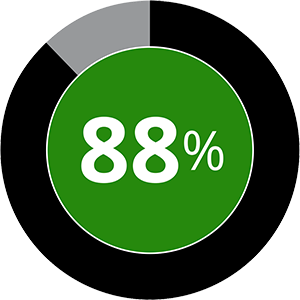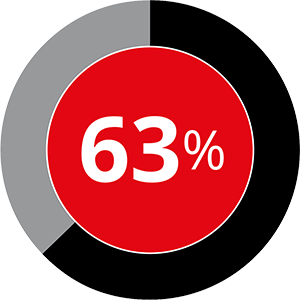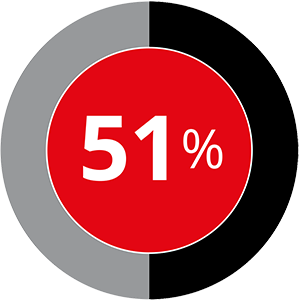Back to business
How ready is Canada for a return to the workplace?
Recovery in the post-COVID world requires an understanding of the new expectations for physical, emotional, financial, and digital safety in the workplace. We asked Canadian organizations how they felt about reopening their doors in the face of these unique challenges.
Assessing Canada’s readiness to reopen
As governments throughout the country begin loosening measures and reopening economies, organizations are starting to plan the safest way to return to their physical workplaces. But key questions remain, not just around how ready organization are for this transition, but also about what the future of work looks likes in the wake of COVID-19. Will a return to the workplace be a return to normality, or does the future of work need a rethinking?
Our five key 'Back to business' pillars have helped organizations assess their recommencement strategy:
We asked over 300 business leaders, in various industries across Canada, to perform a self-assessment around their readiness to try and understand how prepared Canadian organizations are to reopen their physical workplace. The respondents included organizations that ranged from small organizations, to large-scale enterprises.
Organizations across all industries ranked themselves as having a high level of comfort in aligning to government guidelines and protecting employee health and well-being. In general, those surveyed prioritized each area as follows:
Area |
Green |
Amber |
Red |
|
|---|---|---|---|---|
Aligning to government guidelines |
||||
Protecting employee health and well-being |
||||
Effectively managing their workforce |
||||
Providing a safe physical workplace and ecosystem |
||||
Creating a cross-functional command centre |
Green indicates a strong feeling of readiness. Amber indicates readiness, but with more work left to be done, and red indicates considerable preparation is still required.

Organizations feel 88% ready to align with government guidelines
We asked organizations how aware they were of the legislative requirements of reopening, as well as their confidence in being able to effectively measuring and monitoring compliance with these government guidelines and regulations. The combination of these two areas—classed as aligning to government guidelines—averaged the highest readiness level (88 percent) across all organizations. Among the industries surveyed, consumer business and transportation, manufacturing, and government and public services all felt they were well prepared to aligning with government guidelines when reopening their workplace.
Organizations that operate in multiple jurisdictions are likely to face more complexity with varying government guidelines, meaning organizations will need to balance total compliance with providing a consistent experience for employees. Employees returning to physical workplaces will expect it to be safe, and that employers are taking the appropriate steps to protect them. It’s also important to note that some industries may be less attuned to remote work, for example, remote work may require changes in worker education, performance management, organizational structures, and cultural beliefs or stigmas around not being in the office.

Organizations feel ready to equip their employees to collaborate and work effectively remotely, but on average felt 63% equipped to offer training options for new skills, requirements, and strategies to ensure continued workforce success
In contrast to the strong levels of readiness in aligning to government guidelines, organizations didn’t demonstrate as much readiness in effectively managing their workforce. When asked if they had adequately explored training options for new skills and requirements, as well as other strategies to ensure their workforce thrives in the future, respondents only felt 63 percent prepared. During the initial phase of crisis response, some organizations began to review where digital technologies, automation, and AI could make work safer, faster, better, and more innovative. The drop off in readiness to explore training options for new skills and strategies could indicate organizations are not necessarily considering continued investment in new technology, instead focusing their recommencement strategies on the immediate challenges of reopening. We can see in general, readiness to effectively manage the workforce (Figure 1) fluctuates a lot more from industry-to-industry.
COVID-19 has highlighted the necessity for organizations to cultivate a more symbiotic relationship between their workforce and new technologies. For many, these tools have kept teams connected and facilitated, to some extent, continued operations during this crisis. In the future, organizations should continue to cultivate an increasingly tech-savvy workforce and will need to re-engage and rethink their work, workforce, and workplace priorities and opportunities. As their workforce becomes more driven by technology, organizations will also need to ensure data privacy and cybersecurity measures also evolve.
During the recovery phase, organizations now have a unique opportunity to rapidly assess and evaluate their earlier workforce strategies and response priorities. Organizations must find a way to review their way of working, accelerating towards future work models that both address short-term operational requirements, as well as longer term strategic vision. While many may be tempted to dismiss the need for change or imagine recovery as a return to the recent past, organizations that return to their old ways of working may find their competitors have used this period to re-imagine their workforce, positioning themselves to thrive in the future.
Figure 1
Readiness to effectively manage organizations’ workforce by industry
Governement & Public Services
87%
Other
79%
Real Estate
79%
Manufacturing
77%
Financial Services
76%
Technology, Media & Telecommunications
74%
Life Sciences & Health Care
71%
Energy & Resources
67%
Consumer Business & Transportation
66%

Beyond reskilling: COVID-19 as a catalyst for investment
The COVID-19 pandemic has changed the way we work and live, and these changes may prove to be permanent. Adaptability and flexibility will be essential for individuals to thrive in a fast-changing, sometimes uncertain world of work. A commitment to lifelong learning is also critical to enabling individuals to continue building their careers in the post-coronavirus new normal. New skills will be needed as the nature of work itself evolves—skills often gained through the online learning tools that have surged in popularity during the pandemic.
The possibility? Organizations should now consider offering opportunities that allow workers to grow and adapt, rather than rely on their existing skills or certifications. We’re currently at a moment where investment in workforce development is more crucial than ever to adapt in the face of constant change. Learn more about how to build a future-ready workforce.

Only half of organizations have successfully set up a cross-functional command centre for centralized governance and oversight
Almost all the industries we survey demonstrated low levels of readiness to create a cross-functional command centre (Figure 2), only life science and health care organizations felt strongly prepared. A command centre can equip an organization with data, metrics, and key performance indicators that can ensure the appropriate level of monitoring and compliance during this time of recovery. It can also help ensure preparedness and responsiveness in the case of future waves of the virus.
Figure 2
Readiness to create a cross-functional command centre by industry
Life Sciences & Health Care
64%
Governement & Public Services
57%
Manufacturing
57%
Financial Services
56%
Technology, Media & Telecommunications
55%
Other
49%
Energy & Resources
42%
Real Estate
41%
Consumer Business & Transportation
34%

Creating a command centre could provide a central hub to help an organization rebuild, restore, and recover on a national scale. It can become a powerful driver for overdue reform and build an organization’s long-term ability to respond and recover from future crises despite our survey data showing that so many organizations have neglected this important component.
Is Canada ready to return to the workplace?
Many organizations in Canada feel prepared to meet the immediate health and safety requirements of reopening. The majority of them understand which government regulations they need to meet and seem confident in their ability to do so. But many questions and unknowns still remain around how to best evolve workforce functions, both onsite and remotely, and resilient leaders—regardless of how prepared they may feel—should consider answering the core strategic questions around returning to the workplace to ensure that reopening is not a step back, but a step towards further recovery and ultimately, towards thriving again in the next normal.
Related Content
Explore more of Deloitte’s insights related to returning to the workplace and combatting COVID-19.
Read more

